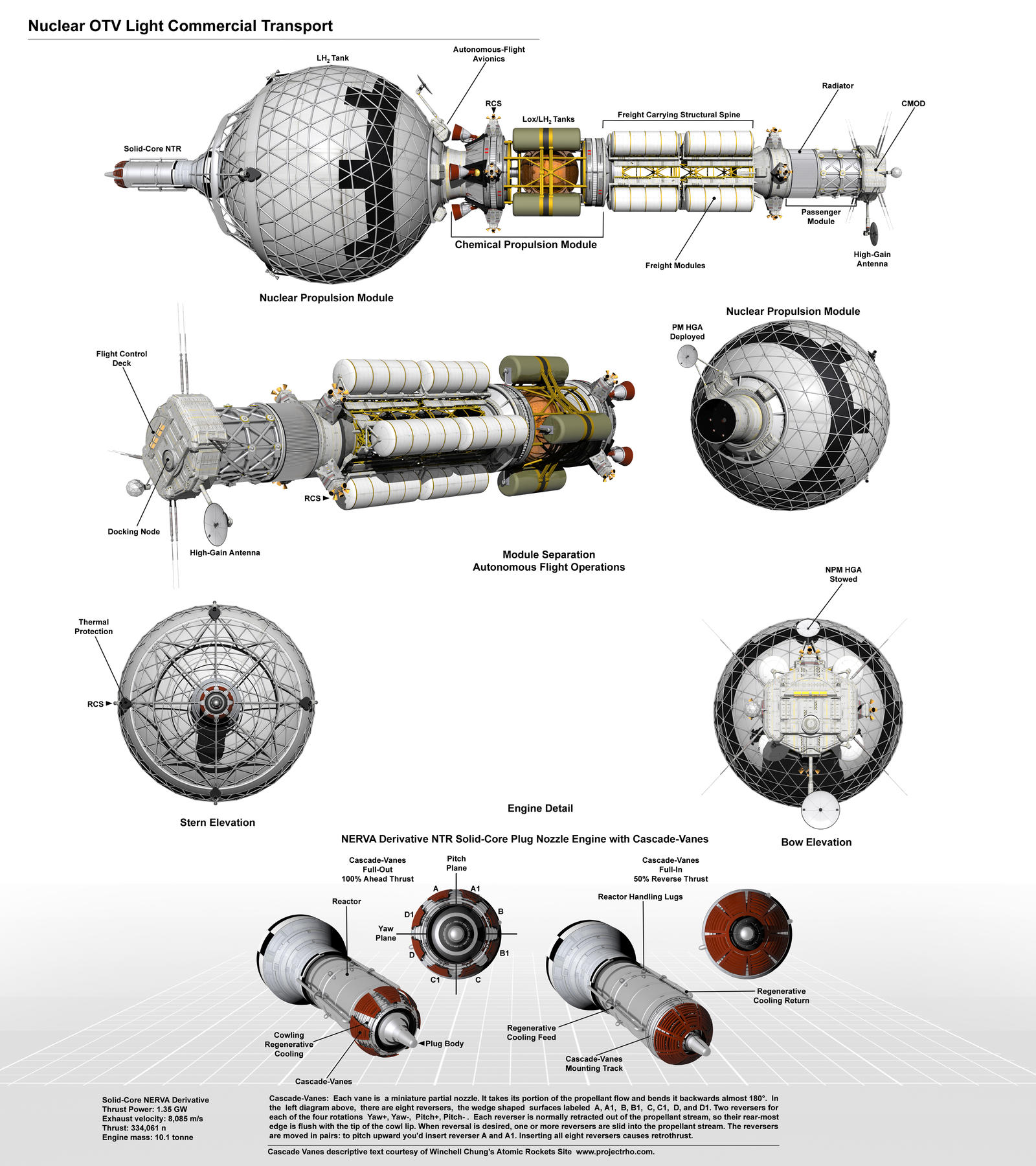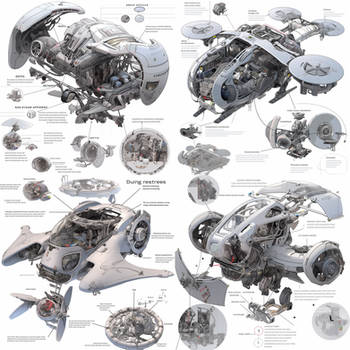ShopDreamUp AI ArtDreamUp
Deviation Actions
Description
Full Resolution Digital Print: $12.00
Orders can be placed at wblack42@sbcglobal.net
See my profile page for details.
Light Freighter for intraorbital service between space colonies and industrial platforms, designed for the System States Era of my Orion’s Arm future history setting.
Image featured on Winchell Chung’s Atomic Rockets site, Realistic Designs page, Link: Nuclear OTV Commercial Transport Diagram.
In the System States Era asteroid mining operations thrive throughout the asteroid belt and among the moons of Jupiter and Saturn the Martian terraforming program has left legacy: a sprawling archipelago of island stations and industrialized moons, Bernal Sphere's and O'Neill Cylinders, Spindle and Wheel cities, and a population of humanity growing into the millions. Space colonies are independent city-states and trade is their lifeblood. Entire generations are born and live their lives in spinning cylinders, bubbles, and torus shaped habitats, harvesting, mining, and fabricating all they need from the environment of the outer solar system.
Orion and Medusa style nuclear pulse freighters haul payloads of raw materials across interplanetary distances, while nuclear orbital transfer vehicles (OTV’s) provide light freight and passenger service between space habitats in Jupiter and Saturn orbit.
For a table of Delta V required for travel using Hohmann orbits among the moons of Saturn see
Why Saturn on Winchell Chung’s Atomic Rockets site. Scroll a little further down the page and you will find a Synodic Periods and Transit Times for Hohmann Travel table for Moons of Saturn.
Nuclear propulsion Systems: Operational Constraints
The abundance of various chemical ices for use as reaction mass among the moons of the outer system gas giants makes NERVA an excellent option for commercial application. Nuclear thermal rockets provide excellent efficiency; they also impose certain operational restrictions. The engine emits significant levels of radiation while firing and even after shut-down, and while passengers and crew are protected by the engines shadow-shield and hydrogen tanks, you wouldn’t want to point the engine at other spacecraft or space platforms. During the U.S. nuclear thermal rocket engine development program NFSD contractors had recommended that no piloted spacecraft approach to within 100 miles behind or to the sides of an operating NERVA I engine. The only safe approach to a spacecraft with a NERVA engine is through the conical “safe-zone” within the radiation shadow created by its shadow-shield and hydrogen tanks. Docking NERVA propelled spacecraft to a space station or habitat is problematic because structures protruding outside the conical safe-zone can reflect radiation back at the spacecraft, irradiating the passengers and crew.
These facts impose a set of mandatory operational parameters and flight rules for nuclear operation. An exclusion zone for nuclear propulsion (60 kilometers minimum) is imposed around every orbital platform. Orbital Guard units would hold broad discretionary powers—violate an exclusion-zone or disregard traffic-control and the local guard will cheerfully vaporize your spacecraft. No warning shots, no second chances. A crew that violates flight rules doesn’t live long enough to worry about fines or attorney fees, and the public’s time and funds are not wasted with trials of incompetent captains and crew.
Nuclear Freighters “park” propulsion modules in station-keeping orbit with their destination, and the freight/passenger module undocks, separating from its nuclear propulsion module, proceeding to birthing under thrust of a chemical maneuvering unit.
Because the nuclear propulsion modules are valuable, and are potentially deadly missiles if mishandled — codes to access the autonomous flight computer and possession of the nuclear propulsion module are temporarily handed over to the local orbital-guard for safe keeping.
For a good example of Space traffic control see the entry on Winchell Chung’s Atomic Rockets site here and scroll down to quote from Manna by Lee Correy.
At this point in my future history, 750 years post Martian colonization, spacecraft are essentially stacks of common modules which can be swapped out to suit application.
Independent Operators, like today’s truckers, might “own” only the CMOD (Command Module) with other units being leased per flight. The Freight Carrying Structural Spine, essentially a rigid frame with mountings for cargo modules, might be leased by the shipper and loaded with cargo (but owned by a separate freight transport supplier) and since different payloads mass differently it might be the responsibility of the shipper to lease suitable nuclear and chemical propulsion modules rated to the task. Passenger transport services might likewise lease passenger modules of varying capacity and Transport Brokerage firms would coordinate freight and passenger payloads assigned to same destinations and offer these in an open-bid market.
Propulsion Modules
Different payload masses require different propulsion module configurations, the light freighter detailed here requires only a single Solid-Core nuclear thermal rocket. A heavy payload freighter might use clusters of solid-core, or Open-Cycle Gas-Core, nuclear thermal rockets.
A timeline for my future history is to be found here: Timeline
Design
3D models are my own conception based on various real-world proposals.
As research for the passenger/crew module I studied the POTV (Personnel Orbital Transfer Vehicle) pages 86-96 from NASA Technical Memorandum 58238 Satellite Power System: Concept Development and Evaluation Program Volume VI1 -Space Transportation available: here.
Propulsion for my light freighter is a Solid-Core NERVA Derivative, details available here.
In conversation Winchell Chung suggested the modification Cascade-Vanes: details available here.
Related Image: Nuclear OTV Commercial Transport
Orders can be placed at wblack42@sbcglobal.net
See my profile page for details.
Light Freighter for intraorbital service between space colonies and industrial platforms, designed for the System States Era of my Orion’s Arm future history setting.
Image featured on Winchell Chung’s Atomic Rockets site, Realistic Designs page, Link: Nuclear OTV Commercial Transport Diagram.
In the System States Era asteroid mining operations thrive throughout the asteroid belt and among the moons of Jupiter and Saturn the Martian terraforming program has left legacy: a sprawling archipelago of island stations and industrialized moons, Bernal Sphere's and O'Neill Cylinders, Spindle and Wheel cities, and a population of humanity growing into the millions. Space colonies are independent city-states and trade is their lifeblood. Entire generations are born and live their lives in spinning cylinders, bubbles, and torus shaped habitats, harvesting, mining, and fabricating all they need from the environment of the outer solar system.
Orion and Medusa style nuclear pulse freighters haul payloads of raw materials across interplanetary distances, while nuclear orbital transfer vehicles (OTV’s) provide light freight and passenger service between space habitats in Jupiter and Saturn orbit.
For a table of Delta V required for travel using Hohmann orbits among the moons of Saturn see
Why Saturn on Winchell Chung’s Atomic Rockets site. Scroll a little further down the page and you will find a Synodic Periods and Transit Times for Hohmann Travel table for Moons of Saturn.
Nuclear propulsion Systems: Operational Constraints
The abundance of various chemical ices for use as reaction mass among the moons of the outer system gas giants makes NERVA an excellent option for commercial application. Nuclear thermal rockets provide excellent efficiency; they also impose certain operational restrictions. The engine emits significant levels of radiation while firing and even after shut-down, and while passengers and crew are protected by the engines shadow-shield and hydrogen tanks, you wouldn’t want to point the engine at other spacecraft or space platforms. During the U.S. nuclear thermal rocket engine development program NFSD contractors had recommended that no piloted spacecraft approach to within 100 miles behind or to the sides of an operating NERVA I engine. The only safe approach to a spacecraft with a NERVA engine is through the conical “safe-zone” within the radiation shadow created by its shadow-shield and hydrogen tanks. Docking NERVA propelled spacecraft to a space station or habitat is problematic because structures protruding outside the conical safe-zone can reflect radiation back at the spacecraft, irradiating the passengers and crew.
These facts impose a set of mandatory operational parameters and flight rules for nuclear operation. An exclusion zone for nuclear propulsion (60 kilometers minimum) is imposed around every orbital platform. Orbital Guard units would hold broad discretionary powers—violate an exclusion-zone or disregard traffic-control and the local guard will cheerfully vaporize your spacecraft. No warning shots, no second chances. A crew that violates flight rules doesn’t live long enough to worry about fines or attorney fees, and the public’s time and funds are not wasted with trials of incompetent captains and crew.
Nuclear Freighters “park” propulsion modules in station-keeping orbit with their destination, and the freight/passenger module undocks, separating from its nuclear propulsion module, proceeding to birthing under thrust of a chemical maneuvering unit.
Because the nuclear propulsion modules are valuable, and are potentially deadly missiles if mishandled — codes to access the autonomous flight computer and possession of the nuclear propulsion module are temporarily handed over to the local orbital-guard for safe keeping.
For a good example of Space traffic control see the entry on Winchell Chung’s Atomic Rockets site here and scroll down to quote from Manna by Lee Correy.
At this point in my future history, 750 years post Martian colonization, spacecraft are essentially stacks of common modules which can be swapped out to suit application.
Independent Operators, like today’s truckers, might “own” only the CMOD (Command Module) with other units being leased per flight. The Freight Carrying Structural Spine, essentially a rigid frame with mountings for cargo modules, might be leased by the shipper and loaded with cargo (but owned by a separate freight transport supplier) and since different payloads mass differently it might be the responsibility of the shipper to lease suitable nuclear and chemical propulsion modules rated to the task. Passenger transport services might likewise lease passenger modules of varying capacity and Transport Brokerage firms would coordinate freight and passenger payloads assigned to same destinations and offer these in an open-bid market.
Propulsion Modules
Different payload masses require different propulsion module configurations, the light freighter detailed here requires only a single Solid-Core nuclear thermal rocket. A heavy payload freighter might use clusters of solid-core, or Open-Cycle Gas-Core, nuclear thermal rockets.
A timeline for my future history is to be found here: Timeline
Design
3D models are my own conception based on various real-world proposals.
As research for the passenger/crew module I studied the POTV (Personnel Orbital Transfer Vehicle) pages 86-96 from NASA Technical Memorandum 58238 Satellite Power System: Concept Development and Evaluation Program Volume VI1 -Space Transportation available: here.
Propulsion for my light freighter is a Solid-Core NERVA Derivative, details available here.
In conversation Winchell Chung suggested the modification Cascade-Vanes: details available here.
Related Image: Nuclear OTV Commercial Transport
Image size
4000x4500px 4.73 MB
© 2014 - 2024 William-Black
Comments37
Join the community to add your comment. Already a deviant? Log In
btw is it alright i can add this to my group?











![MAKS Multipurpose Aerospace System ortho [1] [new]](https://images-wixmp-ed30a86b8c4ca887773594c2.wixmp.com/f/e0dc8eb0-7eb3-4716-b7a1-4364a45acdc0/d7qh57x-abbc03c5-45f8-4d42-869c-a4efdafce108.jpg/v1/crop/w_184)
![Shuttle Crawler Tech Readout [New]](https://images-wixmp-ed30a86b8c4ca887773594c2.wixmp.com/f/e0dc8eb0-7eb3-4716-b7a1-4364a45acdc0/d8cz8rt-116b571f-fb40-421a-89e5-76a9d9d44e53.jpg/v1/crop/w_184)
![Shuttle Buran and Energia ortho [new]](https://images-wixmp-ed30a86b8c4ca887773594c2.wixmp.com/f/e0dc8eb0-7eb3-4716-b7a1-4364a45acdc0/d7knc7g-0feb041e-7ab4-4716-84e2-b8b0664a5383.jpg/v1/crop/w_184)























